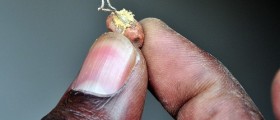
Definition
Entamoeba histolytica is a parasitic protozoan responsible for a rather severe infection in humans. Around 50 million people all around the world are infested with this parasite. Entamoeba histolytica is actually a single cell organism that multiplies by binary fission. The process of multiplication takes place in the gastrointestinal tract, to be more precise the colon.
The parasite infiltrates the wall of the large intestine, leads to ulcerations and triggers bloody diarrhea, a typical sign of the disease. In rare occasions the parasite may enter the bloodstream and spread to other organs and tissues. For instance, Entamoeba may spread to the liver where it triggers formation of liver abscess. Apart from the liver, abscesses associated with Entamoeba histolytica additionally form in the lungs or the brain.
The Life Cycle of Entamoeba Histolytica
The life cycle of this parasite is basically similar to a life cycle of any other parasite. The parasite grows and develops through 2 stages, as an infective cyst and a trophozoite, a form responsible for all the symptoms and signs of the disease.
Even though some animals may be hosts of the parasite, the primary host are humans. Once released, the cysts may stay alive for many months in case the environment is wet. Heat and cold are known to destroy the parasite in the cystic form.
The infection is contracted by ingesting the cysts. Once they enter the gastrointestinal tract the parasite enters the second stage known as a trophozoite. The initial trophozoite has 4 nuclei, it easily divides into four daughter cells and they divide further forming the total of 8 initial trophozoites. What follows is multiplication of trophozoites in the large colon. Certain number of parasites will eventually undergo the process of encystation, forming the cysts that are eliminated with stool, representing a source of parasites ready to infest other humans. Trophozoides are capable of penetrating the wall of the large intestine and they easily reach the liver or some other organs triggering already mentioned abscesses.
The Effects of Entamoeba Histolytica and Treatment
The parasite is a cause of bloody diarrhea. Additional symptoms and signs of amebic dysentery include abdominal pain, weight loss, fatigue and dehydration. Dehydration is particularly harmful to infants, small children and elderly patients. Under certain circumstances the colon gets affected by an inflammatory process medically known as ameboma. This inflammatory formation also known as an amebic granuloma causes large local lesion of the colon and may easily trigger bowel obstruction. Even though fever is present in the majority of patients, sometimes it does not have to occur.
One more serious complication of Entamoeba histolytica is amebic liver abscess. There can be one or several abscesses and they may additionally vary in size. Fortunately, this complication can be easily brought under control will medications (antibiotics) and many times patients successfully avoid drainage procedures and surgical excision of the abscess. Still, in case of abscess rupture, a person inevitably develops shock and dies. The parasite is also very harmful to individuals with already compromised immune system such as those suffering from AIDS.
Entamoeba histolytica can be isolated from the patient's stool. Trophozoites are, for instance, visible in a fresh fecal smears. Additional help is obtained from ELISA and RIA tests.
As for treatment, most patients are treated on an outpatient basis while those with severe colitis, liver abscess, fulminant colitis, peritonitis and rupture of the liver abscess need to be hospitalized.
People with asymptomatic amebiasis are generally prescribed iodoquinol, paromomycin or diloxanide furoate, all of which can successfully eradicate the parasite. Inflammation of the colon requires metronidazole. After a course of metronidazole, patients may additionally need to take one of the previously mentioned luminal agents. This treatment modality is efficient against colonization. Amebic liver abscess responds well to metronidazole although surgical drainage might be necessary if the abscess lingers in spite of aggressive medicamentous treatment. Finally, disseminated form of the disease is treated with metronidazole. The drug is capable of crossing the brain-blood barrier, therefore it can efficiently kill the parasite even if it reaches the brain.
Relevant Data
Contamination of water is a leading cause of infestation with Entamoeba histolytica. As a matter of fact, water contamination with the parasite was the cause of the most severe Entamoeba histolytica outbreak in the United States. It occurred in 1933 in Chicago as a result of contamination of drinking water with sewage water. According to statistics 1,000 people were infected and 58 died. Today in the United States the infection does not occur epidemically but rather in a form of scattered infections caused by improper food handling.
And finally, taking all the mentioned into consideration prevention of this parasitic disease can be successfully achieved by eradicating fecal contamination of food and/or water. Sanitation, hygiene and water treatment must all be impeccable and improved. Since cysts are resistant to soap and low concentrations of chlorine and iodine, water in endemic areas must be boiled for at least 1 minute before being used.

















Your thoughts on this
Loading...